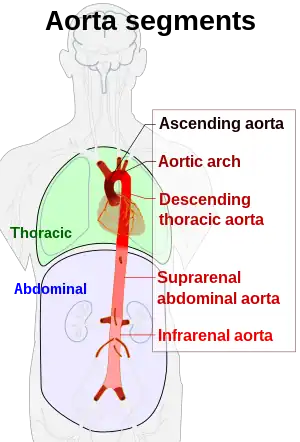| Aortic rupture | |
|---|---|
 | |
| Aorta segments, with thoracic aorta in area marked in green. | |
| Specialty | Vascular surgery, cardiology, emergency medicine |
| Symptoms | Abdominal pain, flank pain, or back pain |
| Complications | Shock, anemia |
| Usual onset | Acute |
| Causes | Ruptured aortic aneurysm, trauma |
| Treatment | Surgical repair |
| Prognosis | Poor |
| Deaths | Up to 90% of cases |
Aortic rupture is the rupture or breakage of the aorta, the largest artery in the body. Aortic rupture is a rare, extremely dangerous condition. The most common cause is an abdominal aortic aneurysm that has ruptured spontaneously. Aortic rupture is distinct from aortic dissection, which is a tear through the inner wall of the aorta that can block the flow of blood through the aorta to the heart or abdominal organs.
An aortic rupture can be classified according to its cause into one of the following main types:
- Traumatic aortic rupture
- Aortic rupture secondary to an aortic aneurysm[1]
Signs and symptoms
Symptoms
- Tearing pain, located in the abdomen, flank, groin, or back
- Loss of consciousness
Signs
Causes
The most common cause of aortic rupture is a ruptured aortic aneurysm. Other causes include trauma and iatrogenic (procedure-related) causes.
Mechanism
The wall of the aorta is an elastic structure which requires integrity. Rupture results from either loss of wall strength to the point at which systemic pressure is greater than wall strength, or external destruction of the wall of the aorta, by a tumor or traumatic means. The bleeding can be retroperitoneal or intraperitoneal, or the rupture can create an aortocaval (between the aorta and inferior vena cava) or aortoenteric (between the aorta and intestine) fistula.
Diagnosis
The condition is often suspected in patients close to death with abdominal trauma or with relevant risk-factors. Diagnosis may be confirmed by ultrasound or X-ray computed tomography (CT) scan.
Prevention
Prevention of aortic rupture begins with screening for disease of the aorta. If indicated, treatment with EVAR or open repair of the diseased aorta can limit the risk of aortic rupture.
Treatment
Aortic ruptures can be repaired surgically via open aortic surgery or using endovascular therapy (EVAR), regardless of cause, just as non-ruptured aortic aneurysms are repaired. An aortic occlusion balloon can be placed to stabilize the patient and prevent further blood loss prior to the induction of anesthesia.
Prognosis
An aortic rupture is a catastrophic medical emergency. People rarely survive such an injury. Mortality from aortic rupture is up to 90%. 65–75% of patients die before they arrive at hospital and up to 90% die before they reach the operating room.[2]
References
- ↑ Ruptured Aortic Aneurysm at Patient UK. Original Author: Laurence Knott. Current Version: Gurvinder Rull. Peer Reviewer: Hannah Gronow. Last Checked: 16/05/2012
- ↑ Brown, LC; Powell, JT (September 1999). "Risk factors for aneurysm rupture in patients kept under ultrasound surveillance. UK Small Aneurysm Trial Participants". Annals of Surgery. 230 (3): 289–96, discussion 296-7. doi:10.1097/00000658-199909000-00002. PMC 1420874. PMID 10493476.